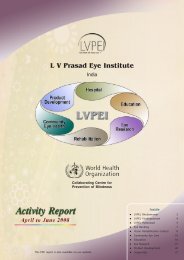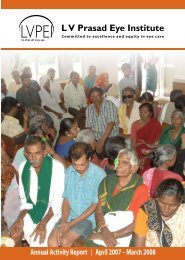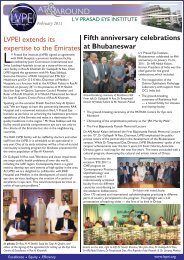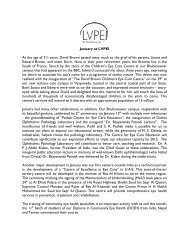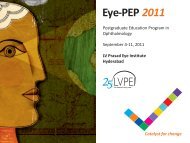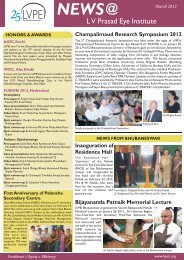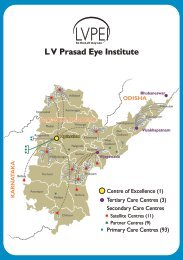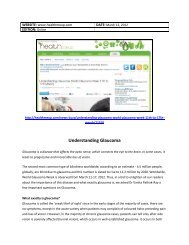IERG Abstracrt Book.indd - LV Prasad Eye Institute
IERG Abstracrt Book.indd - LV Prasad Eye Institute
IERG Abstracrt Book.indd - LV Prasad Eye Institute
You also want an ePaper? Increase the reach of your titles
YUMPU automatically turns print PDFs into web optimized ePapers that Google loves.
Basic Poster Sessions73Purpose: To evaluate nPCRs targeting MPB64 gene, IS6110 region and “Quantiferon TB goldIT test” (QFT –IT) as diagnostic tests in clinically suspected tuberculous uveitis patients.Methodology: QFT –IT (Cellestis, USA) test was performed for 200 plasma samples. nPCRtargeting MPB64 gene and IS6110 region was performed from 200 plasma samples followingprotocols standardized in our laboratory.Results: Of the 200 plasma samples included in the study, 107 (54.5%)were QFT-IT testpositive, 93 were negative and 63 were positive for either one or both the nPCRs and 137were negative. Among the 107 Quantiferon positive samples, 36 were positive by nPCRs (2both nPCRs, 11 by MPB64 nPCR and 23 by IS6110 nPCR) and among the 93 Quantiferonnegative samples, 27 were positive by nPCRs (5 by both nPCRs, 8 only by MPB64 nPCR and 14only by IS6110 nPCR). Considering PCR as the gold standard the sensitivity and specificity ofQFT-IT test was 55%and 42% respectively.Conclusions: To the best of our knowledge, this is the first study to compare the results ofQFT –IT test and for association of M. tuberculosis in peripheral blood of clinically suspectedtuberculous uveitis patients. The nPCRs targeting MPB64 gene and IS6110 region is a valuableadjunct for the association of M. tuberculosis in uveitis patients.IBP 022Free Amino Acids Recover PON1 Activity from the Effect of AGES Bharathi , K N Sulochana , N AngayarkanniVision Research Foundation, Chennai, IndiaPurpose: Paraoxonase-1 (PON1) is a calcium dependent esterase associated with high densitylipoprotein that prevents accumulation of oxidized LDL. Serum PON1 is low in subjects withType 1 and Type 2 diabetes leading to dysfunctional HDL with impaired antioxidant capacity.The effect of advanced glycation end products (AGEs) on endothelial dysfunction is well knownand the effect of AGE on PON is unknown. Therefore the objective of the study is to test theeffect of AGE with and without amino acids on the PON activity in bovine retinal endothelialcells (BREC) as we have previously shown that amino acids mitigate diabetic complications.Methods: The BREC cells were treated with varying concentrations of AGE (50, 100, 500 and1000 µg/ml) in DMEM/F12 media for 24 hrs with and without amino acids ( with 5mM Glycine,Glutamic acid, Leucine, Lysine and Cysteine) to test if they augment PON activity. Activity wasmeasured in cell lysates using a spectrophotometric kinetic assay.Results: There was a dose dependent decrease in the PON activity with increasingconcentration of AGE. The amino acids treated cells showed a 10 - 30% increase in PONactivity when compared to AGE treated, with a maximal effect seen for glycine followed byglutamic acid, cysteine and lysine.Conclusions: This study shows the novel beneficial role of amino acids in improving theactivity of PON which is a therapeutic target for atherosclerosis, now gaining importance alsoin diabetic retinopathy.



